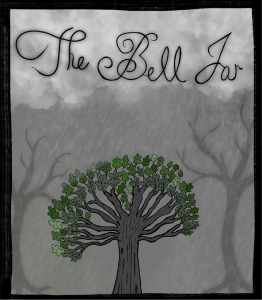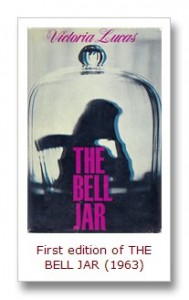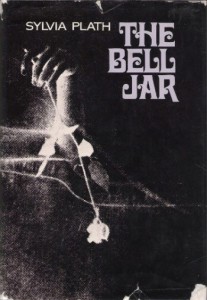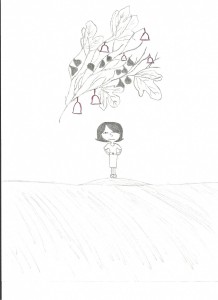Daily Archives: May 6, 2014
Project # 2 (Part 2)

I used this image of a woman looking at a fig tree for my cover because the fig tree was brought up numerous times throughout the book to represent how Esther viewed her own life and the different branches it represents in it. At first it was mentioned in Chapter 5, when Esther connected with the story of the Jewish man and Nun meeting at the fig tree. She relates to her own experience with buddy. “It seemed to me Buddy Willard and I were like that Jewish man and that nun, although of course we weren’t Jewish or Catholic but Unitarian. We had met together under our own imaginary fig tree, and what we had seen wasn’t a bird coming out of an egg but a baby coming out of a woman, and then something awful happened and we went our separate ways.” (Plath, chapter 5) She connects the way the relationship between the Jewish man and the Nun is doomed after they’ve touched hands, the way hers and Buddy’s is doomed. Also, they’re very similar to the Jewish man and Nun due to their differing outlook on life, especially their gender differences.
In chapter 7, Esther mentions the fig tree once more when she is with Constantine and the Russian woman who can recite so many different idioms. She thinks about how inadequate she feels compared to these people and think about the many different ways her own life can branch out. “I saw myself sitting in the crotch of this fig tree, starving to death, just because I couldn’t make up my mind which of the figs I would choose. I wanted each and every one of them, but choosing one meant losing all the rest, and, as I sat there, unable to decide, the figs began to wrinkle and go black, and, one by one, they plopped to the ground at my feet.”(Plath, Chapter 7) She feels that because she is a woman, she has many more responsibilities and options that she can choose. She feels as though she can only choose one way and ends up feeling troubled and indecisive.
This image I chose shows a girl looking out at the tree and the different figs and to me it mainly connects back to Chapter 7 as Esther contemplates her own decisions in life and where she wants to go from there.She has many different possibilities to choose from but this is a great dilemma because she wants to do it all.
The Bell Jar Project 2 Final: A Woman Alone
Final Paper: belljarfinal
Part 2: Project 2 part 2
This is my cover for part 2 of the project. Please check the link for more info on what inspired it, and the program i used to create this image. I would love any feedback from classmates! Thanks everyone.
The Bell Jar Project
Project #2
Cover 1

cover 2 
The Bell Jar by Sylvia Plath is a story of elapsed time. The protagonist Esther Greenwood starts off as a normal college student but over time she starts to act differently. She goes under pressure in life. She doesn’t know who she wants to be and exactly what she wants in life. Over time people around the world started designing covers for the story. Some are very hard to understand and some pin point the main points from the story. I believe that the cover should portray the story’s theme. It should also reflect the symbols that are used in the story. So when I was looking for book covers I was looking for something with the theme and symbols I had in mind. The symbol I had in mind was a jar. The themes I would like to discuss are expectations leading to disappointments and the regrowth or rebirth from suffering and pain. The first cover I chose was published in 1963 in London by Heinemann. The cover has the author’s name on the top and the title on the bottom middle in bold pink letters. The cover itself is black and white. On the cover there is a girl sitting on a chair resting her head on her hand. There is a bell jar and it seems like the girl is inside the bell jar. The second cover I chose was published in New York in 1971 by Harper & Row. The cover is a hand letting go of a rose. I look at the letting go of the rose as a rebellious act. Throughout Esther’s life she acts in rage. Her actions are very rebellious.
In college Esther starts to date Buddy but does not have a sexual relationship with him. Her mother approves Buddy and expects her to marry him. Later in time she bumps into a professor at college, Irvin. She loses her virginity to him. The whole situation of being married and having a family worries Esther because she won’t be able to be a poet. She is a successful poet with college education and does not want that to go to waste. This situation worsens her madness. The first cover reflects Esther trying to decide what she wants to do. What decision she is trying to make. This cover is shown in a way that she is trapped inside the jar. With so many responsibilities and hobbies Esther doesn’t know which one to carry on with. In a sense she feels trapped. When Esther comes home from New York she was rejected from a writing course she wanted to get into. That was one of the disappointments Esther faced. Esther was highly disappointed by her boyfriend who wanted her to stop writing and be pure. Buddy lectured Esther on the importance of being pure and clean. Right after that he told her he had sex with a waitress over 30 times. Esther faced such a huge disappointment after hearing that from Buddy.
“I sank back in the gray, plush seat and closed my eyes. The air of the bell jar wadded round me and I couldn’t stir” (Plath, Chapter 15). Esther explains how she is feeling and what she feels like she’s going through. She feels that she is trapped and there’s no way out. She’s breathing the same air, the air filled with negativity. This quote reflects the body posture of Esther inside the bell jar. Esther was very disappointed in life. She didn’t know exactly what she wanted.
Coming across this cover I realized it portrays the restrictions put on women in America in the 1950s. Women in the 1950s were expected to get married and raise a family. In this cover Esther is slouching, and with such body posture it is very predictable that she is worried. “A man doesn’t have a worry in the world, while I’ve got a baby hanging over my head like a big stick, to keep me in line” (Plath, Chapter 18). Esther thinks that a man doesn’t have anything for worry about. They have all the rights and freedom. Meanwhile if she gets married she is expected to have a baby. Esther worried that once she gets married she would have to choose either her married life with children or her writing career.
There was the symbol of a fig tree throughout the novel. The fig tree stood for the options and choices Esther had in store for her. “I saw myself sitting in the crotch of this fig tree, starving to death, just because I couldn’t make up my mind which of the figs I would choose. I wanted each and every one of them, but choosing one meant losing all the rest, and, as I sat there, unable to decide, the figs began to wrinkle and go black, and, one by one, they plopped to the ground at my feet” (Plath, Chapter 7). Esther struggles when it comes to men. She doesn’t know who she should go for or who to seduce. Esther imagines each fig represents a different life. The only problem is she can only one fig. Esther becomes very indecisive, and starts to think very hard. Meanwhile the figs are rotting and fall to the grounding. With the choice in life Esther becomes very overwhelmed. She begins to worry. On the cover Esther’s body posture is slouched with her head resting on her hand. I look at this as a posture people are in when they are stresses, overwhelmed and worried.
The biggest rebellious move is when Esther tries to commit suicide. Esther gives up in life overall and tries to get away from all the problems and the options she has to choose from. This led her in the hospital. From shock therapies to get medicine, Esther was constantly in and out the hospital. Being there is only a forearm on the second cover, I see this is weakness. People tend to slit their wrists when committing suicide because if the cut it deep enough it leads to death due to the artery connected to the heart. Esther rebels against her own life. But she fails to do so. In this cover Esther’s arm looks very weak. I can relate this to when Esther was going through her shock treatments. “But each time I would get the cord so tight I could feel a rushing in my ears and a flush of blood in my face, my hands would weaken and let go, and I would be all right again” (Plath, Chapter 13). Esther expresses her weakness she goes through and asks for mercy to be relieved from the pain.
“Then my hands jerked free, and I fell back onto my mother’s bed. A small hole, blackened as if with pencil lead, pitted the center of my right palm” (Plath, Chapter 12). This quote is when Esther was getting shock treatments by Doctor Gordon. After the treatment was done for the day, the doctor asked Esther how she was feeling. Although she said she was fine she was in pain. In this quote Esther explains her pain in great detail. This quote can also be applied to the cover because of her description when her hands were free.
“That afternoon my mother had brought me the roses. “Save them for my funeral,” I’d said. My mother’s face puckered, and she looked ready to cry. “But Esther, don’t you remember what day it is today?” “No.” I thought it might be Saint Valentine’s Day. “It’s your birthday.” And that was when I had dumped the roses in the waste-basket” (Plath, Chapter 16). During this scene Esther’s mother brings her roses for her birthday at the hospital. Esther throws the roses out. This scene is what came to my mind when I saw the second cover. It shows how Esther didn’t appreciate her mother or her mother’s feelings. Esther begins to rebel her mother’s care for her.
Part Two

I have chosen this cover for many reasons. It shows the theme of hospital and blood. Hospitalization and blood are repetitive themes throughout the book. Esther was in the hospital for shock therapy, going to visit a doctor about her problems, and when she was bleeding. Esther was hospitalized after overdosing on sleeping pills, in an attempt to commit suicide. Blood has an important throughout the novel as well. Blood was caused from the pain and harm she was put through or she put herself through. When Marco tried to rape her, Esther punched him leading him to bleed. When Esther was getting suicidal thoughts, she began to practice cutting her calf to get ready to cut her wrist. While slashing her calf she was bleeding and there was blood in that scene as well. Another scene where Esther bled was when she lost her virginity to Irvin. She refuses to be comforted by Irvin and heads to the hospital. The blood represents the scary experiences that Esther faced during her lifetime. This picture can also reflect when Esther went to Dr. Nolan, who gave her talk therapy, insulin injections and shock therapy, all in the comfort of one hospital and under one doctor’s care. On this picture the blood is drawing the heart rates. The heart relates to the scene where she tried to kill herself but her body strives to survive. Since the waves are not flat in the picture it resembles when Esther’s heart does not give up on her and wants to live. The image can only be seen as a rebirth from all the trauma Esther went through. Her ability to live regardless her countless attempts to kill herself. This cover has many scenes within and can definitely be used as a cover for The Bell Jar.
Project #2
Part 1

The first edition, 1963

Perennial Edition, 2000
The cover of a book has the power of making customers purchase something they normally wouldn’t, or it can make them ignore a title they probably would enjoy reading. As a prospect reader walks down the aisle of a bookstore, the cover of a book has normally very limited time to capture someone’s attention. In a sea of different color schemes, materials and shapes, a cover has to have that extra “something” to catch people’s attention. Many books succeed at being picked up by using bright colors and shiny paper, but fail at transmitting the real essence of the title.
Sylvia Plath’s “The Bell Jar” certainly isn’t a book that can easily be summarized with a cover. The novel portrays the journey of a young lady, Esther, who walks down a rather troubled path in her life. Throughout the story, she deals with different types of disillusion, which lead her to acute depression. At first, one may think she has everything going for her: she’s smart, funny; her professional life seems to be going well. As the story develops, it’s clear that Esther’s take on life is a rather tortured one. She doesn’t seem to be able to enjoy her achievements and can’t seem to relate to what is going on around her. Throughout the novel, Esther shares thoughts that support that idea, such as: “The trouble was, I had been inadequate all along, I simply hadn’t thought about it.” (Plath 70) That’s only one example of how the lack of empathy towards the world is a part of her life. She never seems to find a group she truly fits in and she hasn’t been able to acquire long-term friendships either.
“The Bell Jar” was first published in 1963 and, since then, it has featured over 30 different artworks for its cover; and the first edition published has a very interesting one. The cover is composed of a black and white picture of a woman sitting at a desk in what seems to be a bedroom or a home office, as the background. From what can be seen from a lateral view, she rests her elbow on the desk and her hand on the chin. On the foreground, it is possible to see a bell jar, which gives the impression that the woman could be in it. The glass distorts the image of the woman behind it, and it makes her figure look a bit warped. The idea of a bell jar, also present in the title of the novel, is a reference to an analogy that Esther uses several times to describe her feelings: “I would be sitting under the same glass bell jar, stewing in my own sour air.”(185) This “bell jar” symbolizes her struggles in life, which always suffocate her in low self-esteem form and it makes her never feel satisfied with what she achieves. That’s clear when she says, “I was supposed to be having the time of my life.”(2) She acknowledges that she should be happy, but she’s unable to properly feel that way.
In this first edition’s cover it is only possible to see her dark silhouette against a well-lit background, which gives the artwork a sinister feel and supports the subject of the novel. Alongside the dark colors of the photograph, the typography follows that same imagery. Both title of the book and name of the author (“Victoria Lucas”, Plath’s penname) are portrayed in a shade of purple. The title of the book appears with a large point-size, all caps and centered at the bottom; and it takes up almost the entire bottom half of the cover. The other typographic addition is the name of the author, up top, with the same purple, but written in cursive typeface, giving it a more delicate motif. The typographic choices add up to the dramatic atmosphere that the story inspires.
Another cover that succeeds at capturing the essence of “The Bell Jar” is the “Perennial Classics” version, from 2000. It also features a woman in a black and white photograph. This time, the woman is outdoors in what seems to be a backyard. She is wearing a white dress, against a dark background formed by trees. That brings up an element that played an important role in the novel: the fig tree reference.
“I saw my life branching out before me like the green fig tree in the story. From the tip of every branch, like a fat purple fig, a wonderful future beckoned and winked. One fig was a husband and a happy home and children, and another fig was a famous poet and another fig was a brilliant professor, and another fig was Ee Gee, the amazing editor, and another fig was Europe and Africa and South America, and another fig was Constantin and Socrates and Attila and a pack of other lovers with queer names and offbeat professions, and another fig was an Olympic lady crew champion, and beyond and above these figs were many more figs I couldn’t quite make out. I saw myself sitting in the crotch of this fig tree, starving to death, just because I couldn’t make up my mind which of the figs I would choose. I wanted each and every one of them, but choosing one meant losing all the rest, and, as I sat there, unable to decide, the figs began to wrinkle and go black, and, one by one, they plopped to the ground at my feet.”(77)
That is a very important, since it touches a major issue for Esther—the lack of assuredness in her life. She is an intelligent woman who would easily be able to follow a successful career path based on her academic records, but isn’t able to do so due to insecurities and, again, the lack of self-esteem. This “Perennial Classics” cover speaks to that as it has the face of the woman blurred out, as a way of conveying lack of identity, something Esther deals with. She can’t decide what she wants for her future and isn’t able to make crucial life decisions, which frustrates her even further.
This artwork also features purple typeface for the title of the book, but it’s in a lighter tone compared to the first edition, which makes it look more girly and adds to the innocent feel that the white—and somewhat short—dress also suggests. The name of the author (this time her real one) is written in white lower-case letters; also suggesting a soothing and young theme.
The fact that the woman appears in the back of the photo, reading as some distance from the foreground, and the way she’s pictured alone, play with the concept of solitude and indecisiveness once again. Here’s a quote from the novel that supports that thought: “The same thing happened over and over: I would catch sight of some flawless man in the distance, but as soon as he moved closer I immediately saw he wouldn’t do at all.”(83) Just like in this quote, the woman in the picture looks almost lost, looking for something or someone; but at the same time she doesn’t look like she’s about to go anywhere. Esther feels that way in many different moments, such as in this following one: “When they asked me what I wanted to be I said I didn’t know.”(101) She didn’t even know who she was, or what she wanted to be—let alone which direction she wanted her life to take; and this version of the book cover dialogs with that idea.
Both covers here discussed—the first edition and the “Perennial Classics” version—do a great job conveying the main points of the novel. The first one dabbles more deeply with the gloomy aspect of depression, by portraying the woman in a distorted way and in dark colors. This cover also features a more obvious reference to the bell jar, having the actual object as part of the artwork. The “Perennial Classics” cover is subtler in its references, leaving more to be further analyzed. This latter one focuses more on the lack of self-identity Esther struggled with throughout the novel—hence the woman’s blurred face, just standing still in a garden. The imagery of this cover is a more youthful one, as it brings up the notion of Esther’s unpreparedness to deal with life’s challenges.
It’s hard to decide which one has more efficient results. The two covers have similarities: both have black and white photographs, feature a woman, have purple typography, and play with light/dark. It’s interesting to see that they were made 37 years apart and yet have a lot in common. It’s left to be wondered of the first edition had its cover design authorized by the author, since she was still alive when it was published. It summarizes the idea of the novel very well, and so does the “Perennial Classics” version.
Not all of the various cover designs for “The Bell Jar” had such positive outcomes. Many missed the point in portraying the Esther Greenwood’s gloomy personality and her hardships in life. It’s hard to imagine how an artwork featuring bright colors and festive typography can be faithful to a story that narrates the experiences of a woman dealing with depression. With a few exceptions, almost all cover options have, rightfully, dimmed colors and a serious approach.
As mentioned before, “The Bell Jar” isn’t an easy novel to be translated into a book cover, but the two ones here analyzed perform the job really well. Whoever sees these artworks are able to at least have an idea of what the novel is about, and that’s exactly what you want from a book cover.
Part 2
For the creation of my own cover, I used two major references in the novel: the bell jar and the fig tree metaphors. The first one appears in various moments of the story and it symbolizes Esther’s fears, frustrations and pain. She feels trapped inside this bell jar that keeps her from enjoying life. “To the person in the bell jar, blank and stopped as a dead baby, the world itself is a bad dream.”(237) She is talking about herself, who suffers from depression and can’t seem to be able to enjoy life.
The other reference, with the figs, is an allusion to the many different goals she wants to achieve, but doesn’t think she will. She says: “I saw myself sitting in the crotch of this fig tree, starving to death, just because I couldn’t make up my mind which of the figs I would choose. I wanted each and every one of them, but choosing one meant losing all the rest, and, as I sat there, unable to decide, the figs began to wrinkle and go black, and, one by one, they plopped to the ground at my feet.”(77) Esther has so many possible ways to succeed in life, and yet she’s overwhelmed and can’t follow any plan in depth.
The cover was put together with the thought of having the figs trapped inside the bell jar, representing two main ideas:
– The figs, or her dreams, were there within reachable distance and she could get them if she wanted, but something was keeping her from doing so: depression.
– Her goals, or her expectations in life, were also suffocating her, just like the bell jar.
I went with that typographic choice because it’s delicate and dark, just like Esther’s mind. I distorted the figs to give them the same gloomy feel Esther describes in the story. I made them look darker so it seems like they’re going bad and Esther is running out of time to eat them, translating into the nerve-wrecking scenario she’s living in.
Blogging for Thursday: photos and shawls
Featured
For Thursday, please read the two story pairings:
Zadie Smith, “Scenes from the Smith Family Christmas” and photograph; Jamaica Kincaid, “Biography of a Dress” (and listen to her read the story)
and Cynthia Ozick, “The Shawl” (932-935) and Louise Erdrich, “The Shawl” (1409-1413)
Then write a post, approximately 300 words or longer, either the photobiography or the object-biography, using the categories Homework Responses and the name of the author or authors you’re imitating or drawing on.:
The Photobiography: imitating the style and themes of Smith or Kincaid, who tell their stories through careful consideration of a photograph from their pasts, write a creative close-reading of an old photograph of yourself. Include the photograph if possible. Tag your post Photobiography.
The Object-biography: considering how both Ozick and Erdrich tell these story with the object of the shawl as an important object, both physically and symbolically, write a creative close-reading about an object of significance to you or your family. Include a photograph of the object if possible. Tag your post Object-biography.
Blogging for Tuesday: Commenting on covers
Featured
Now that Project #2 posts are starting to appear, offer your classmates some feedback on their book-cover or image creations. Choose one and reply with a comment, approximately 150 words, even if you haven’t finished your own project! Reviewing what your classmates have achieved might help you finish yours if you haven’t already.
It would be great if when you post, even if you’re linking a file for the written work, to include the image for Part 2 in your post, so that it’s easy to see. It can entice us to click your link to read more about your cover.
As you complete Project #2, I’m sure you’re eagerly reading the excellent stories selected for this week. They’re in two pairs, and I’ll post a homework assignment soon for you to complete for Thursday. We’re moving into our most contemporary literature–enjoy!








